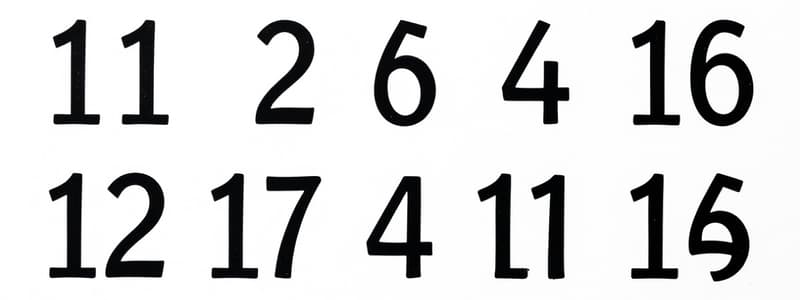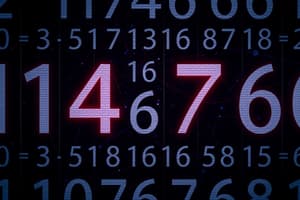Podcast
Questions and Answers
What is the correct outcome of the subtraction 125 - -34?
What is the correct outcome of the subtraction 125 - -34?
- 91
- 159 (correct)
- 125
- 157
If you multiply the integers -5 and -5, what is the product?
If you multiply the integers -5 and -5, what is the product?
- 25 (correct)
- 10
- -10
- -25
What is the greatest common factor (GCF) of 12 and 16?
What is the greatest common factor (GCF) of 12 and 16?
- 8
- 4 (correct)
- 2
- 6
What is the sum of -12 and 8?
What is the sum of -12 and 8?
Which statement correctly describes adding two negative integers?
Which statement correctly describes adding two negative integers?
What would the result be when multiplying 7 and -3?
What would the result be when multiplying 7 and -3?
If the LCM of two numbers is 36, which pair of numbers could they be?
If the LCM of two numbers is 36, which pair of numbers could they be?
What will be the sign of the product when dividing two numbers with unlike signs?
What will be the sign of the product when dividing two numbers with unlike signs?
Which of the following is a prime number?
Which of the following is a prime number?
What is the result of dividing -144 by -12?
What is the result of dividing -144 by -12?
How is 1 classified in terms of prime and composite numbers?
How is 1 classified in terms of prime and composite numbers?
Which of the following describes a composite number?
Which of the following describes a composite number?
What do you get when you divide -120 by 4?
What do you get when you divide -120 by 4?
What is the prime factorization process initiated with?
What is the prime factorization process initiated with?
What is the result of the expression 45 ÷ -5?
What is the result of the expression 45 ÷ -5?
Flashcards are hidden until you start studying
Study Notes
Operations on Integers
- Operations include addition, subtraction, multiplication, and division of signed integers.
- Target skills: perform operations on integers, apply rules in word problems, define prime, composite, factors, and multiples, list prime factors, and find GCF and LCM.
Rules on Signed Numbers: Addition
- Same Sign:
- Add the absolute values, keep the sign (e.g., 8 + 14 = 22; -5 + -5 = -10).
- Unlike Sign:
- Subtract the smaller absolute value from the larger, keep the sign of the larger number (e.g., 54 + -12 = 42; -40 + 5 = -35).
Rules on Signed Numbers: Subtraction
- To subtract, change the sign of the subtrahend and follow addition rules (e.g., 56 - 23 becomes 56 + -23).
Rules on Signed Numbers: Multiplication
- Same Sign: Product is positive (e.g., -5 * -5 = 25).
- Unlike Sign: Product is negative (e.g., 8 * -3 = -24).
Rules on Signed Numbers: Division
- Similar to multiplication, the signs determine the result:
- Same Sign: Result is positive (e.g., -12 ÷ -12 = 1).
- Unlike Sign: Result is negative (e.g., 81 ÷ -3 = -27).
Prime and Composite Numbers
- Prime Numbers:
- Natural numbers with exactly two positive factors: 1 and itself (e.g., 2, 3, 5).
- Composite Numbers:
- Natural numbers greater than 1 with more than two factors (e.g., 35, factors are 1, 5, 7, 35).
- Note: 1 is neither prime nor composite, while 2 is the smallest prime number.
Prime Factorization
- The unique representation of a number as a product of prime numbers.
- All integers greater than 1 can be expressed as products of prime factors (Theorem).
- To find it:
- Divide by the smallest prime (2), then subsequently by larger primes (3, 5, etc.) until reaching 1.
Recall Points for Operations
- For addition and subtraction, apply the rules depending on the signs. For multiplication and division, ensure to account for the signs properly to determine the result.
Studying That Suits You
Use AI to generate personalized quizzes and flashcards to suit your learning preferences.




